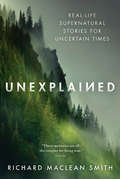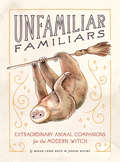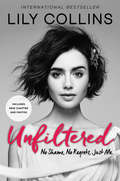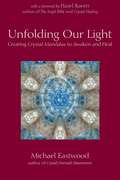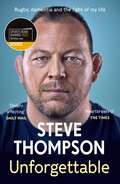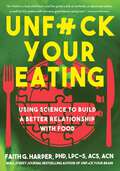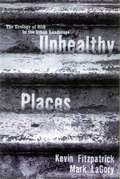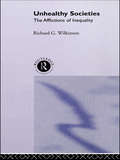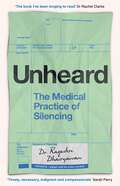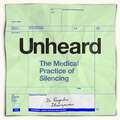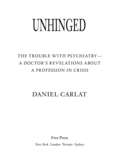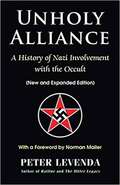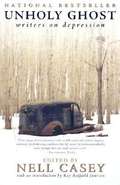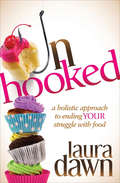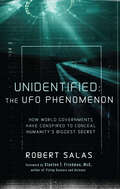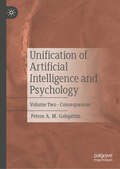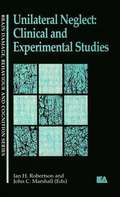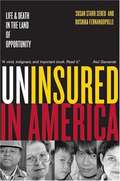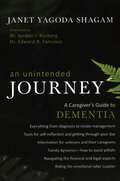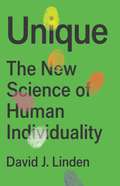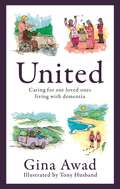- Table View
- List View
Unexplained: Real-Life Supernatural Stories for Uncertain Times
by Richard MacLean SmithIn every corner of this earth there are secrets. They are hidden in the dark edge of the woods, nestled in the cold stars, and staring out from a stranger's eyes. And whether they be demonic possession or an unsolved murder, the unknown has always haunted our dreams. From the hit podcast Unexplained comes a volume perfectly crafted for the curious, the cynical, and the not-easily-frightened. Richard Maclean Smith is the expert in the unknown, and humbly offers up ten tales of real-life events that continue to evade explanation. With these chilling stories comes the missing key: a connection to our own beliefs in science, superstition, and perception. What can a case of demonic possession teach us about free will? What can a cursed box show us about the act of storytelling? What can a supposed instance of reincarnation tell us about developing a concept of the self? Perhaps some things are just better left unexplained...
Unfamiliar Familiars: Extraordinary Animal Companions for the Modern Witch
by Megan Lynn Kott Justin DeVineUnfamiliar Familiars is a comprehensive and humorous handbook to finding and caring for the unconventional animal companion.This guide will help you find the animal best suited to your personality and particular magical needs.Animals include a narwhal (strong in clairvoyance and fencing), an albatross (best for sea-faring witches), or an earthworm (for garden-based magic and fish summoning).• Features real-world facts with a playful, magical spin• Includes a helpful quiz for finding your own familiar• Brimming with suggested names, strengths, weaknesses, and moreForget the toads and black cats: Every witch is unique, so shouldn't you have a familiar as one-of-a-kind and extraordinary as yourself? Unfamiliar Familiars is an entertaining and educational guide to a menagerie of magical, less-appreciated creatures that may just become your ideal partner in the arcane arts.• Filled with quirky, charming watercolor illustrations• Perfect for anyone who wants to find their own familiar, just as they love learning about their own horoscope, zodiac reading, or Pottermore Patronus• Sure to delight animal lovers who have a sense of humor• You'll love this book if you love books like Sad Animal Facts by Brooke Barker; Basic Witches: How to Summon Success, Banish Drama, and Raise Hell with Your Coven by Jaya Saxena and Jess Zimmerman; and The Wild Unknown Animal Spirit Deck and Guidebook by Kim Krans.
Unfiltered: No Shame, No Regrets, Just Me.
by Lily CollinsIn this groundbreaking debut essay collection, featuring never-before-seen photos, actress Lily Collins—star of Mortal Instruments and Rules Don’t Apply—is opening a poignant, honest conversation about the things young women struggle with: body image, self-confidence, relationships, family, dating, and so much more.For the first time ever, Lily shares her life and her own deepest secrets, underlining that every single one of us experiences pain and heartbreak. We all understand what it’s like to live in the light and in the dark. For Lily, it’s about making it through to the other side, where you love what you see in the mirror and where you embrace yourself just as you are. She's learned that all it takes is one person standing up and saying something for everyone else to realize they’re not alone.By turns hilarious and heartbreaking, Lily’s honest voice will inspire you to be who you are and say what you feel. It’s time to claim your voice! It’s time to live your life unfiltered.
Unfolding Our Light
by Michael Eastwood Hazel RavenBased on his work with the Crystal Oversouls, Unfolding Our Light explores a new vision for an awakening humanity which takes into account the changes to the traditional model of auras and chakras. The book explains Eastwood's childhood connection to light-beings and a particular experience he had as a child. This experience connected him directly to light-beings and their guidance. The book follows the light-beings' message: "In Lemuria your vastness was reflected through at least ten layers of your aura as well as ten chakras, awakened and fully operational. In this lifetime humanity, as well as all kingdoms of this planet, will awaken from this slumber through an initiation - the like that has not been since since Lemurian times. This initiation will activate the ten layers of your aura as well as all ten chakras. Through this you and humanity will remember union with the wider universe. This human initiation will be keenly watched by the inner planes as well as other star worlds - it involves them too."
Unforgettable: Rugby, dementia, and the fight of my life
by Steve Thompson“I'm in My Early Forties. There are Days When I Don't Remember the Names of My Wife and Four Kids . . .”“So powerful. This book might just change the way you think about sport forever” ─Sir Clive Woodward, English rugby union footballer and coachWinner of the Sunday Times Sports Book of the Year Award 2023England won the 2003 Rugby World Cup. At the heart of this triumph was Steve Thompson, a formidable presence in England's front row, navigating the intense battles of the scrum. However, the euphoria of victory came at a staggering cost and today, Steve Thompson has no recollection of that momentous final. To him, watching the tape of that match is like peering into the life of a ghost. Steve has been diagnosed with early onset dementia, and serious progressive brain damage.A testament to the resilience of the human spirit. Unforgettable is the story of unwavering hope and unyielding courage, woven together with raw, powerful storytelling. This poignant sports memoir features contributions from his fellow world-cup winning teammates and his former manager, Sir Clive Woodward. As Steve grapples with the unrelenting challenges of dementia, he not only confronts his own past but also becomes a symbol of endurance, demonstrating that strength transcends the limits of the rugby field.Inside, learn what it’s like:Dealing with a life change and learning to navigate life with dementiaFor rugby players to be pushing past the limitReevaluating what’s important and navigating new family dynamicsIf you have read other sports memoirs and biographies such as Open, Straight Shooter, or Choosing to Run, then Unforgettable is for you!
Unfuck Your Eating: Using Science to Build a Better Relationship with Food, Health, and Body Image
by Dr Faith G. HarperFood is complicated. And our relationships with food and eating are all kinds of fucked up. It doesn't help that cultural messages about health, diet, body image, and weight are fatphobic and often medically dangerous. Dr. Faith Harper, author of the bestselling Unfuck Your Brain and Unfuck Your Body, brings her trademark combination of science, humor, and real talk to help us work through our food, health, and body image issues and develop a healthier relationship with food so that it can fuel us and bring us pleasure. She delves into the difference between eating disorders and disordered eating and the causes and consequences of both, breaks down the difference between various behaviors, tackles trauma and other co-occurring conditions, and provides compassionate and practical steps to improve your eating habits and repair your relationship with yourself.
Ungalaal Mudiyum!
by T. KamarajThis Tamil book written in an educative language deals with Male sexual disorders both physical and Psychological. The topics include-Sexual dysfunctions or malfunctions, uncommon orgasm disorders, erectile dysfunction-the causes, symptoms, clinical studies, remedies and treatment.
Unhealthy Places: The Ecology of Risk in the Urban Landscape
by Kevin Fitzpatrick Mark LagoryAn awakening argument on modern day health hazards and how they are directly proportional to the unhealthiness of urban environment.
Unhealthy Societies: The Afflictions of Inequality
by Richard G. WilkinsonAmong the developed countries it is not the richest societies which have the best health, but those which have the smallest income differences between rich and poor. Inequality and relative poverty have absolute effects: they increase death rates. But why? How can smaller income differences raise average life expectancy?Using examples from the USA, Britain, Japan and Eastern Europe, and bringing together evidence from the social and medical sciences, Unhealthy Socities provides the explanation. Healthy, egalitarian societies are more socially cohesive. They have a stronger community life and suffer fewer of the corrosive effects of inequality. As well as inequality weakening the social fabric, damaging health and increasing crime rates, Unhealthy Societies shows that social cohesion is crucial to the quality of life.The contrast between the material success and social failure of modern societies marks an imbalance which needs attention. The relationship between health and equality suggests that important social needs will go unmet without a larger measure of social and distributive justice. This path-breaking book is essential reading for health psychologists, sociologists, welfare economists, social policy analysts and all those concerned with the future of developed societies.
Unheard: The Medical Practice of Silencing
by Dr Rageshri DhairyawanHave you ever felt unheard by your doctor? Been frustrated that they haven't understood your symptoms, that they have neglected your concerns?When Dr Rageshri Dhairyawan was admitted to hospital as a patient she didn't receive the pain medication that she told them she needed, despite her being a senior doctor. It was in that moment she understood that something was deeply wrong with our healthcare system. Doctors aren't listening, and it is making us ill.In Unheard, Dr Dhairyawan takes us on a journey through history to show how not listening to patients has been ingrained in medicine from its inception. Western medicine has been built on the assumption that power should always lie with the doctor, and that patients should be powerless to decisions made about their body if it is done to make them well. This, alongside the prejudices of society, has led to dramatic gaps in medical knowledge because for centuries people have not been heard.Dr Dhairyawan offers a way to reshape our health system for a future where active and engaged listening is the new frontier in a timely, shocking and engaging exposé of the medical world.
Unheard: The Medical Practice of Silencing
by Dr Rageshri DhairyawanHave you ever felt unheard by your doctor? Been frustrated that they haven't understood your symptoms, that they have neglected your concerns?When Dr Rageshri Dhairyawan was admitted to hospital as a patient she didn't receive the pain medication that she told them she needed, despite her being a senior doctor. It was in that moment she understood that something was deeply wrong with our healthcare system. Doctors aren't listening, and it is making us ill.In Unheard, Dr Dhairyawan takes us on a journey through history to show how not listening to patients has been ingrained in medicine from its inception. Western medicine has been built on the assumption that power should always lie with the doctor, and that patients should be powerless to decisions made about their body if it is done to make them well. This, alongside the prejudices of society, has led to dramatic gaps in medical knowledge because for centuries people have not been heard.Dr Dhairyawan offers a way to reshape our health system for a future where active and engaged listening is the new frontier in a timely, shocking and engaging exposé of the medical world.
Unhinged: A Doctor's Revelations About a Profession in Crisis
by Daniel CarlatIn this stirring and beautifully written wake-up call, psychiatrist Daniel Carlat exposes deeply disturbing problems plaguing his profession, revealing the ways it has abandoned its essential purpose: to understand the mind, so that psychiatrists can heal mental illness and not just treat symptoms. As he did in his hard-hitting and widely read New York Times Magazine article "Dr. Drug Rep," and as he continues to do in his popular watchdog newsletter, The Carlat Psychiatry Report, he writes with bracing honesty about how psychiatry has so largely forsaken the practice of talk therapy for the seductive and more lucrative practice of simply prescribing drugs, with a host of deeply troubling consequences. Psychiatrists have settled for treating symptoms rather than causes, embracing the apparent medical rigor of DSM diagnoses and prescription in place of learning the more challenging craft of therapeutic counseling, gaining only limited understanding of their patients lives. Talk therapy takes time, whereas the fifteen-minute "med check" allows for more patients and more insurance company reimbursement. Yet DSM diagnoses, he shows, are premised on a good deal less science than we would think. Writing from an insider's perspective, with refreshing forthrightness about his own daily struggles as a practitioner, Dr. Carlat shares a wealth of stories from his own practice and those of others that demonstrate the glaring shortcomings of the standard fifteen-minute patient visit. He also reveals the dangers of rampant diagnoses of bipolar disorder, ADHD, and other "popular" psychiatric disorders, and exposes the risks of the cocktails of medications so many patients are put on. Especially disturbing are the terrible consequences of over-prescription of drugs to children of ever younger ages. Taking us on a tour of the world of pharmaceutical marketing, he also reveals the inner workings of collusion between psychiatrists and drug companies. Concluding with a road map for exactly how the profession should be reformed, Unhinged is vital reading for all those in treatment or considering it, as well as a stirring call to action for the large community of psychiatrists themselves. As physicians and drug companies continue to work together in disquieting and harmful ways, and as diagnoses and misdiagnoses of mental disorders skyrocket, it's essential that Dr. Carlat's bold call for reform is heeded.
Unholy Alliance: A History Of Nazi Involvement With The Occult
by Norman Mailer Peter LevendaIn June of 1979, Peter Levenda flew to Chile―then under martial law―to investigate claims that a mysterious colony and torture center in the Andes Mountains held a key to the relationship between Nazi ideology and its post-war survival on the one hand, and occult ideas and practices on the other. He was detained there briefly and released with a warning: “You are not welcome in this country.” The people who warned him were not Chileans but Germans, not government officials but agents of the assassination network Operation Condor. They were also Nazis, providing a sanctuary for men like Josef Mengele, Hans-Ulrich Rudel, and Otto Skorzeny. In other words: ODESSA. <P><P> Published in 1995, Unholy Alliance was the first book in English on the subject of Nazi occultism to be based on the captured Nazi archives themselves, as well as on the author’s personal investigations and interviews, often conducted under dangerous conditions. The book attracted the attention of historians and journalists the world over and has been translated into six languages. A later edition boasts the famous foreword by Norman Mailer. <P><P> How did occultism come to play such an important role in the development of Nazi political ideology? What influence did such German and Austrian occult leaders as Lanz von Liebenfels and Guido von List have over the fledgling Nazi party? What was the Thule Gesellschaft, and who was its creator, Baron von Sebottendorf? Did the Nazi high command really believe in occultism? In astrology? In magic and reincarnation? <P><P> This is a new and expanded edition of the original text, with much additional information on the rise of extremist groups in Europe, Latin America, Asia, and the United States and the esoteric beliefs that are at their foundations. It is the first book in a trilogy that includes Ratline and The Hitler Legacy. This is where it all began.
Unholy Ghost: Writers on Depression
by Nell CaseyUnholy Ghost is a unique collection of essays about depression that, in the spirit of William Styron's Darkness Visible, finds vivid expression for an elusive illness suffered by more than one in five Americans today. Unlike any other memoir of depression, however, Unholy Ghost includes many voices and depicts the most complete portrait of the illness. Lauren Slater eloquently describes her own perilous experience as a pregnant woman on antidepressant medication. Susanna Kaysen, writing for the first time about depression since Girl, Interrupted, criticizes herself and others for making too much of the illness. Larry McMurtry recounts the despair that descended after his quadruple bypass surgery. Meri Danquah describes the challenges of racism and depression. Ann Beattie sees melancholy as a consequence of her writing life. And Donald Hall lovingly remembers the "moody seesaw" of his relationship with his wife, Jane Kenyon. <p><p> The collection also includes an illuminating series of companion pieces. Russell Banks's and Chase Twichell's essays represent husbandand-wife perspectives on depression; Rose Styron's contribution about her husband's struggle with melancholy is paired with an excerpt from William Styron's Darkness Visible; and the book's editor, Nell Casey, juxtaposes her own essay about seeing her sister through her depression with Maud Casey's account of this experience. These companion pieces portray the complicated bond -- a constant grasp for mutual understandingforged by depressives and their family members. <p> With an introduction by Kay Redfield Jamison, Unholy Ghost allows the bewildering experience of depression to be adequately and beautifully rendered. The twenty-two stories that make up this book will offer solace and enlightenment to all readers.
Unhooked: A Holistic Approach to Ending Your Struggle with Food
by Laura DawnBreak unhealthy food habits with these practical steps that combat the mental and emotional factors keeping us hooked, unhappy, and overweight. Our relationship with food extends far beyond survival. It incorporates aspects of physiology, emotions, thought patterns, and how we feel about ourselves—all influenced by a culture that turns food into a source of compulsion and guilt. Despite our best efforts, many of us remain hooked to unhealthy food habits—habits that keep us overweight and unhappy. In Unhooked, Laura Dawn sheds light on the food struggle from six essential perspectives: environmental, physiological, behavioral, mental, emotional, and spiritual. And she provides concrete steps you can take to free yourself from your personal food traps—whether it&’s chronic overeating, incessant cravings, food addiction, yo-yo dieting, disordered eating, or the inability to eat certain foods in moderation. These steps empower us to shift our perspective on food, fueling our transformation to vibrant health and reminding us that we are all worthy of living the healthy lives of our dreams.
Unidentified: How World Governments Have Conspired to Conceal Humanity's Biggest Secret
by Robert Salas“A compelling and heartfelt journey through the minefields and thickets of government secrecy . . . a concise history of the modern UFO phenomenon.” —Thomas J. Carey, bestselling coauthor of Witness to RoswellIn 1969 the US Air Force issued a statement that read‚ “No UFO reported, investigated and evaluated by the Air Force was ever an indication of threat to our national security.” This statement is patently false. It has been proven untrue by the testimony of many military officers and airmen and documentation of incidents involving UFOs and nuclear weapons, testimonies of which the US Air Force was fully aware. Unidentified details many of these testimonies, some for the first time.As partial justification for its position, the Air Force cites a University of Colorado study that was contracted and paid for by federal funds. Unidentified reveals how this study was actually just another part of the plan to cover up the reality of the UFO phenomenon. For the first time, Unidentified publishes evidence that the investigators for the Colorado study knew about the UFO-related missile shutdown incidents but did not investigate them or include them in their final report.Robert Salas, a retired United States Air Force Officer, witnessed first-hand a UAP visiting and disabling nuclear missiles at that Malmstrom Air Force Base and shares his experience as well as the many incidents of the last 80 years of similar visits that have been covered-up.A new expanded edition will be published November 2023 under the title UAPs and the Nuclear Puzzle.“A sober yet heartfelt narrative which dares you to dismiss it without due consideration.” —Fortean Times
Unification of Artificial Intelligence and Psychology: Volume One - Foundations
by Petros A. GelepithisThis book —the first of a two-volume monograph— seeks to unify the hitherto perceived-as-disparate foundations of psychology and artificial intelligence. It does this by replacing their constitutive notions with a novel common one: noémon system. The ensued Theory of Noémon Systems is developed in terms of an interdisciplinary, language- based, axiomatic approach. The first volume details the development of the foundations of the theory and expounds ramifications for cognitive science and AI including novel solutions to the AGI debate and Darwin’s mental gap issue, while offering the first complete definition of AI. The book concurrently explores the similarities and differences between humans and AI/robot systems with respect to the evolution-dependent phenomena of representation, thinking, understanding and communication. The book is an extensive one; because of it’s extensiveness and broad ramifications, this book will appeal to scientists working on the interfaces of psychology, AI, philosophy of mind, neuroscience, and the humanities. The complicated and extensive unification of the fields of Artificial Intelligence and psychology is continued in the second volume that breaks further new ground for both disciplines, with thought-provoking and compelling implications for both.
Unification of Artificial Intelligence and Psychology: Volume Two - Consequences
by Petros A. GelepithisThis book, the second of two-volumes, builds on the unification of Artificial Intelligence and Psychology to explore its consequences. In doing so, this volume unifies three pivotal phenomena of Cognitive Science and AI: knowledge, consciousness and emotions. The extended Theory of Noémon Systems expounds ramifications for cognitive science, philosophy of mind, mathematics, and the issue of the unity of science and art. It also discusses the similarities and differences between humans and AI/robot systems with respect to consciousness, emotions and scientific knowledge. As with the first volume, this book will appeal to scientists working on the interfaces of psychology, AI, philosophy of mind, neuroscience, and the humanities. The complicated and extensive unification of the fields of Artificial Intelligence and psychology breaks entirely new ground for both disciplines, with thought-provoking and compelling implications for both.
Unilateral Neglect: Clinical and Experimental Studies (Brian Damage, Behaviour & Cognition Series)
by Ian H. Robertson John C. Marshall<P>Unilateral neglect is a fairly common disorder, usually associated with a stroke, which results in a neglect or lack of attention to one side of space usually, but not exclusively, the left.<P> Theoretically, it is one of the most interesting and important areas in neuropsychology; practically, it is one of the greatest therapeutic problems facing therapists and rehabilitationists. This book covers all aspects of the disorder, from an historical survey of research to date, through the nature and anatomical bases of neglect, and on to review contemporary theories on the subject. <P>The final section covers behavioral and physical remediation. A greater understanding of unilateral neglect will have important implications not just for this particular disorder but for the understanding of brain function as a whole.
Uninsured in America: Life and Death in the Land of Opportunity
by Susan Starr Sered Rushika FernandopulleThis book was born at a Harvard health care symposium when Rushika, a physician specializing in health policy, met Susan, an anthropologist who recently had returned to the United States after living for two decades in Israel and Japan, countries that have national health care programs.
Unintended Journey: A Caregiver's Guide to Dementia
by Janet Yagoda Shagam*New Edition with Updated dementia, dementia care, and resource information.*According to the Alzheimer&’s Association, there are more than six million people living in the United States have Alzheimer's disease or some other form of dementia. Not reported in these statistics are the sixteen million family caregivers who, in total, contribute nineteen billion hours of unpaid care each year. This book addresses the needs and challenges faced by adult children and other family members who are scrambling to make sense of what is happening to themselves and the loved ones in their care. The author, an experienced medical and science writer known for her ability to clearly explain complex and emotionally sensitive topics, is also a former family caregiver herself. Using both personal narrative and well-researched, expert-verified content, she guides readers through the often-confusing and challenging world of dementia care. She carefully escorts caregivers through the basics of dementia as a brain disorder, its accompanying behaviors, the procedures used to diagnose and stage the disease, and the legal aspects of providing care for an adult who is no longer competent. She also covers topics not usually included in other books on dementia: family dynamics, caregiver burnout, elder abuse, incontinence, finances and paying for care, the challenges same-sex families face, and coping with the eventuality of death and estate management. Each chapter begins with a real-life vignette taken from the author's personal experience and concludes with "Frequently Asked Questions" and "Worksheets" sections. The FAQs tackle specific issues and situations that often make caregiving such a challenge. The worksheets are a tool to help readers organize, evaluate, and self-reflect. A glossary of terms, an appendix, and references for further reading give readers a command of the vocabulary clinicians use and access to valuable resources.
Unique: The New Science of Human Individuality
by David LindenInspired by the abundance of unique personalities available on dating websites, a renowned neuroscientist examines the science of what makes you, you.David J. Linden has devoted his career to understanding the biology common to all humans. But a few years ago he found himself on OkCupid. Looking through that vast catalog of human diversity, he got to wondering: What makes us all so different? Unique is the riveting answer. Exploring everything from the roots of sexuality, gender, and intelligence to whether we like bitter beer, Linden shows how our individuality results not from a competition of nature versus nurture, but rather from a mélange of genes continually responding to our experiences in the world, beginning in the womb. And he shows why individuality matters, as it is our differences that enable us to live together in groups.Told with Linden's unusual combination of authority and openness, seriousness of purpose and wit, Unique is the story of how the factors that make us all human can change and interact to make each of us a singular person.
United We Stand: A Book for People with Multiple Personalities
by Eliana GilThis book is written for individuals with multiple personalities, and explains what multiplicity is, why it develops, how to understand it, and when and how to seek help. Multiples have too long suffered with nagging worries about being crazy or so unique that they cannot have friends or companionship. This book defines multiplicity as a creative and life-saving adaptive strategy, not as a "disorder" or sign of mental illness.
United: Caring for our loved ones living with dementia
by Gina AwadA moving and beautifully illustrated book that captures the real life tales of people living with dementia, as told by their loved ones caring for them.This humorous, heartwarming and often heartbreaking collection will be relatable and supportive for anyone touched by dementia in their lives, and provides insight and information for anyone wanting to know more.The stories reflect on: the impact of receiving a diagnosis, the importance of person-centred care and social inclusion; the power of meaningful engagement, partnerships, peer support and much, much more.
United: Caring for our loved ones living with dementia
by Gina AwadA moving and beautifully illustrated book that captures the real life tales of people living with dementia, as told by their loved ones caring for them.This humorous, heartwarming and often heartbreaking collection will be relatable and supportive for anyone touched by dementia in their lives, and provides insight and information for anyone wanting to know more.The stories reflect on: the impact of receiving a diagnosis, the importance of person-centred care and social inclusion; the power of meaningful engagement, partnerships, peer support and much, much more.
